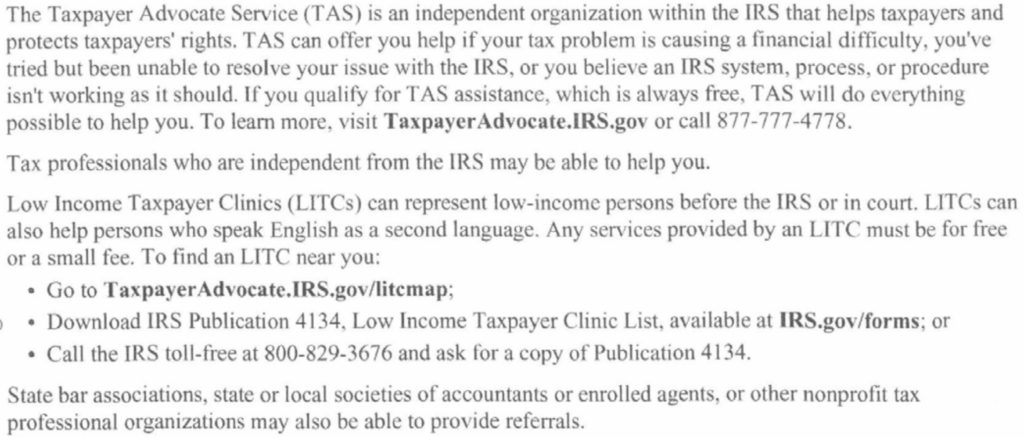IRS Letter 3219: What To Do When the IRS Sends You a Notice of Deficiency
IRS Letter 3219 is the 90-day letter issued by an IRS service center after the IRS either:
- prepares a substitute for return (SFR) for the taxpayer or
- performs a correspondence audit that did not result in an agreement between the IRS and the taxpayer as to how much the taxpayer owes for the tax year in question
The IRS is required by law to mail Letter 3219 via certified mail; below is the image of the certified mail envelope in which the IRS sent Letter 3219 to our client.
As a 90-day letter, IRS Letter 3219 is a statutory notice of deficiency that, if not responded to within 90 days of the date on the letter itself, will result in the IRS assessing the taxes, penalties, and interest described in the letter.
IRS Letter 3219 is generally accompanied by Form 4549, Report of Income Tax Examination Changes, that shows how the IRS calculated its proposed deficiency amount, along with other forms.
For your reference, here are redacted copies of the following items that the IRS sent our client via certified mail:
- Letter 3219 that the IRS issued one of our clients
- Return address sheet that the IRS also enclosed
- Form 5564-A, Notice of Deficiency Waiver, that the IRS also enclosed
- Form 4549, Report of Income Tax Examination Changes, that the IRS also enclosed
- Form 886-A, Explanation of Items, that the IRS also enclosed
- Form 14817, Reply Cover Sheet, that the IRS also enclosed
IRS Letter 3219 At a Glance
| Letter Type: | 90-Day Letter |
| Generated By: | IRS Service Center |
| Preceded By: | Letter 525 |
| Followed By: | Assessment |
| Recommended Action: | Contest Proposed Assessment |
IRS Letter 3219 Explained, Part by Part
Here is a full explanation of the Letter 3219, part by part.
Part 1: Summary of Deficiency
On the first page of your notice of deficiency, you’ll see a table with four columns:
- Tax year ended: This column indicates the tax year for each tax deficiency or penalty / addition the IRS has figured.
- Deficiency amount: This column indicates the amount of the deficiency in tax liability the IRS has figured for the period in question.
- Penalty or addition to tax Internal Revenue Code Section: This column indicates the statutory basis for any penalties or other additions to the tax amount that the IRS has figured.
- Penalty or addition to tax amount: This column indicates the amount of any penalties or other additions to the tax amount that the IRS has figured. Common penalties include:
- The failure-to-file penalty under IRC Section 6651(a)(1)
- The failure-to-pay penalty under IRC Section 6651(a)(2)
- The underpayment of estimated tax penalty under IRC Section 6654(a)
Part 2: Opening Paragraph
In this paragraph, the IRS informs you that:
- you owe the amounts in the table above
- the letter you are reading is a statutorily required notice (IRC Section 6212)
- they are enclosing the audit report showing how the IRS determined the deficiency it has figured
Part 3: What to Do If You Agree
In this part, the IRS informs you that you can agree to the deficiency the IRS has figured by signing and returning Form 5564-A.
Part 4: What to Do If You Disagree
In this part, the IRS informs you that you can contest the IRS’ determination of your deficiency by filing a petition with the Tax Court.
Part 5: How to File Your Tax Court Petition
In this part, the IRS gives you an overview of how to file a petition with the Tax Court.
Filing Electronically
You can file your Tax Court petition electronically by registering for a DAWSON account and then filing the actual petition at ustaxcourt.gov/dawson.html.
Filing via Paper Mail
You can file your Tax Court petition via paper mail by downloading the official Tax Court Petition Kit, completing and signing the petition, and mailing it to:
United States Tax Court
400 Second Street, NW
Washington, DC 20217
Along with your petition, you should also mail the following items:
- A copy of your IRS Letter 3219 with your Social Security Number redacted wherever it appears on the letter
- Your Statement of Taxpayer Identification Number (this is included in the Petition Kit)
- Your Request for Place of Trial (this is included in the Petition Kit)
- The $60 Tax Court petition filing fee, which is payable by check, money order, or other draft, to the “Clerk, United States Tax Court.” In lieu of the fee, you can also submit an application to have the filing fee waived.
Simplified Procedure
If the amount of taxes and penalties the IRS has figured on your IRS Letter 3219 does not exceed $50,000 for any one tax year, then you qualify to have your Tax Court case conducted as a “small tax case” — if you want it to be.
These cases are handled under simpler and less formal procedures that regular cases.
That said, the downside of filing as a small tax case is that you cannot appeal the Tax Court’s decision in a small tax case as you could with a regular tax case.
If you qualify for small tax case treatment, consider carefully whether you want your case handled as a small tax case or as a regular tax case — just because you qualify for small tax case treatment doesn’t mean you have to go that route.
Representation
You can, of course, represent yourself in Tax Court “pro se,” or you can have an attorney or a non-attorney (such as a CPA or EA) who has been admitted to practice before the Tax Court.
Part 6: When to File Your Tax Court Petition
There is a hard deadline to file your Tax Court petition; this deadline is:
- 90 days from the date on the upper-right-hand corner of the first page of the Letter 3219 you received if the letter was addressed to your United States address and you were in the United States on that date, or
- 150 days from the date on the upper-right-hand-corner of the first page of the Letter 3219 you received if the letter was addressed to your non-United States address or if you were outside the United States on that date.
Note that for purposes of the 90-day and 150-day deadlines, your Tax Court petition will be considered timely if the USPS postmark date on the correctly addressed envelope you used to submit your petition is within the 90-day / 150-day period. This is known as the “postmark rule,” and it only applies to mail sent via USPS; you cannot rely on the postmark rule if you mail your petition using the mail service of a foreign country.
Part 7: What to Do If You’re Married
If you’re married, and the IRS believes that both you and your spouse are liable for its proposed deficiency, the IRS will send one Letter 3219 to you and a separate Letter 3219 to your spouse.
If you both want to petition the Tax Court to contest the deficiency, you must either both sign and file the petition or both of you must file a separate petition.
If only one of you files a Tax Court petition and the other spouse is not on that petition, then any Tax Court proceedings would only pertain to the spouse who actually filed the petition.
Part 8: What Will Happen If the IRS Doesn’t Hear From You
If you don’t take any action, the IRS will assess the proposed tax deficiency, along with penalties and interest.
At this point, the IRS can begin the collections process.























